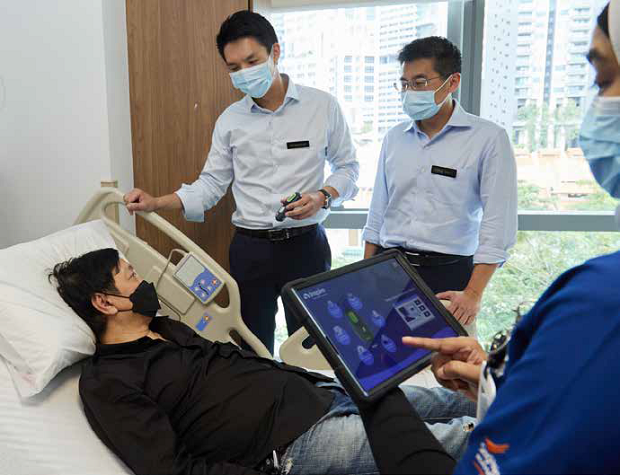
An implantable pulse generator to help keep the airway open is now available in Singapore for patients with obstructive sleep apnoea.
The standard therapy for obstructive sleep apnoea (OSA) is to use a continuous positive airway pressure (CPAP) device to keep the airway open and breathing regular. But the CPAP machine is uncomfortable and needs to be worn for at least four hours every night. A new treatment offers promise — a tiny implant that works much like a pacemaker to deliver mild stimulation to keep the airway open, providing sufferers uninterrupted sleep during the night.
OSA often affects older or heavier people with weaker or slacker throat muscles, which can relax too much when breathing during sleep. As a result, the airway narrows or closes, hampering breathing for a few seconds, rousing the person from sleep. “Hypoglossal nerve stimulation (HGNS) therapy is a good complement and alternative to other treatment options because it is the only procedure that addresses the issue of weak muscles in patients’ airway, to allow them to breathe during sleep,” said Dr Shaun Loh (pictured, below), Consultant, Department of Otorhinolaryngology – Head & Neck Surgery, Singapore General Hospital (SGH). “This is a real game changer in that it is a minimally invasive procedure that is a good alternative to CPAP. It has been proven to reduce breathing interruptions and improve daytime functions. Patients have reported that they are able to comply to the use on a nightly basis.”

The HGNS treatment consists of a programmable neuro-stimulator in the chest, connected to a pressure-sensing lead to detect breathing, and a stimulator lead to mildly stimulate the tongue nerve. Patients undergo surgery — lasting about two hours — to implant the stimulator or pulse generator about the size of three 50-cent coins in the chest just below the collar bone.
Once the device is activated by the patient using a remote control, the stimulation of the airway occurs in sync with the patient’s breathing. Whenever the patient breathes in, the tongue is pushed forward and the airways open. Patients turn on the device before going to bed to gently stimulate the throat muscles while sleeping.
Introduced by the department and SGH’s Sleep Centre in May 2022, the new treatment was first performed on a patient on 27 May 2022. Since then, more than 20 patients have undergone the treatment.
HGNS has been available in the US and Europe since 2014, with more than 40,000 patients having been implanted with the device, and 150 studies published on its efficacy. A New England Journal of Medicine study reported that the device was just as effective at the five-year mark as at the time of implant.

<HGNS therapy is a
good complement and
alternative to other
treatment options for
OSA, say Dr Shaun Loh
and Assoc ProfToh Song Tar (above),Senior Consultant andHead, Department ofOtorhinolaryngology –Head & Neck Surgery, SGH>
Good sleep is needed for brain performance, mood and health. Not getting enough quality sleep increases the risk of diseases and disorders from heart disease and stroke to obesity and dementia. Worldwide, 6–17 per cent of the adult population have at least moderate OSA, while one in three Singaporeans are estimated to suffer from the disorder.
A common but potentially lifethreatening disorder, OSA tends to affect more men than women, and people with a large neck, low-lying soft palate, enlarged tonsils and small jaw with receding chin. Patients can benefit from lifestyle changes such as weight loss and good sleep hygiene. However, for many patients, these lifestyle changes alone are insufficient.
Get the latest updates about Singapore Health in your mailbox! Click here to subscribe.













 Get it on Google Play
Get it on Google Play